Cuckoo clocks: history, types, recommendations for choosing
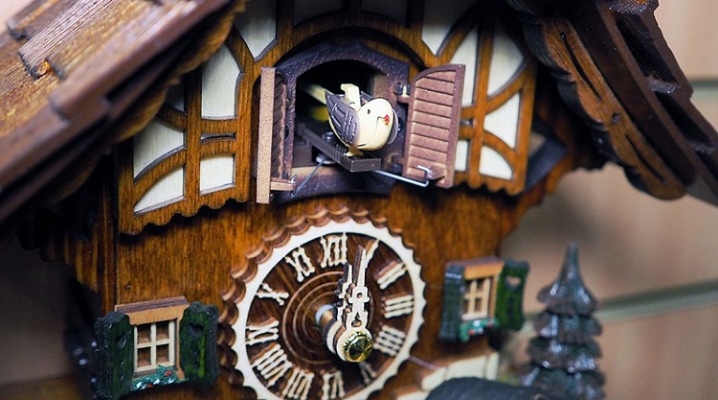
In the past, a bulky mechanical watch served to show the time. They look completely different nowadays. Modern models, in addition to their main function as time markers, are designed to decorate and decorate the space. A special place among all types is occupied by cuckoo clocks. And in the old days, and now they are able to decorate any home. These works of watchmaking are unique in originality and are now in great demand.



A bit of history
Historians offer several legends related to the appearance of the cuckoo clock. So, they are first mentioned in 1629 as a gift to the Saxon Elector Augustus from the courtier Heinhofer... The next mention is found in 1650, when Athanasius Kircher described an organ with moving figures and a cuckoo. In 1669, the Italian watchmaker Domenico Martinelli, seeing a bird settling in the pipes of a church organ, suggested using the cuckoo's cry to signal the arrival of a new hour.
Some historians describe in their writings how the courtiers of Louis XIV presented him with a porcelain clock with shepherdesses waltzing to a melody. Amazed by the gift, the king immediately disassembled the mechanism. And the royal watchmakers, during the repair, replaced the shepherds with hooting owls.


However, Germany is traditionally considered the birthplace of such watches. It is the old German watchmakers who are called their inventors. The story of their creation began as a family peasant entertainment on long winter days. When the snowdrifts covered the entire neighborhood, the peasants carved handicrafts from wood, including clocks with figures of plants, trees and animals. And in the spring they sold them to visiting merchants in order to earn some money. But the figures did not move and the birds were silent.
Franz Anton Ketterer, a resident of the town of Schönwald in the Black Forest, undertook to solve this problem. And in 1730 he came up with a way out. Initially, he tried to make a crowing rooster mechanism. But, faced with the difficulty of reproducing the call of a rooster and the cumbersome structure, he replaced the rooster with a cuckoo. The voice mechanism invented by him has remained almost unchanged to this day.
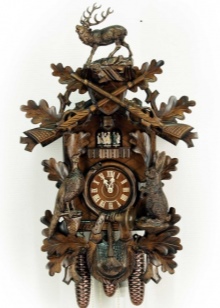

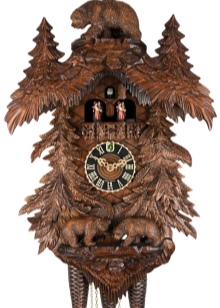
Of course, the first clocks were quite primitive, but since they were made by hand, each cuckoo had a unique look.
The amazing pieces quickly gained popularity in the country, and by the middle of the 18th century they were made from wood with the same wooden mechanism and decorated with carvings, and each craftsman had his own individual style. The first copies had one hour hand, a pendulum from a special block and a stone instead of a weight. Of course, they did not have a precise move. But the craftsmen, replacing the wooden mechanism with a metal one, made them more accurate.
In 1740, the German craftsmen of the Black Forest company created a new and improved mechanism from bellows with air and tubes to reproduce the cry of the cuckoo. A few years later, this innovation made them famous far beyond the borders of Germany.

Rave reviews about the wonderful watches spread throughout Europe and even reached Russia. In the 19th century, the active development of the German industry contributed to the founding of numerous watchmaking companies.
The cuckoo clock, which became the symbol of the Black Forest, is still being produced. Handcrafted with impeccable workmanship, they are eagerly snapped up by tourists from all over the world during their trips to the Black Forest. And they are in great demand among true connoisseurs and collectors of expensive models.

Interesting facts
It is known about six copies of the world's largest cuckoo clocks, received the certificate "The World's Largest Cuckoo Clock" and entered in the Guinness Book of Records. These giants will be able to boast of the city of Wiesbaden, the town of Schonabach in the suburbs of Triberg, the city of Hellsteig, St. Goara, Niederwasser. The height of the Wiesbaden Clock Tower is over 14 meters. It is made entirely of linden and has a pendulum of 100 kg.
It should be noted that in the Russian city of Penza, on Fontannaya Square, there is an 8-meter tower cuckoo clock made at the Serdobsk Mayak Watch Factory. There are also two museums of such watches in the world. The most significant in terms of the number of exhibits is in the UK. Its collection comprises 600 of the rarest antique exhibits. The second is located in the same town of Shonabah.
It is also a store. Those who wish can purchase any copy they like, made by a local craftsman.


Varieties and producers
The cuckoo clock is a mechanism that combines the striking system and the cuckoo, fixed on a bracket and looking out of the opening doors. The execution of cuckoo clocks is varied: from a simple chalet with a bird to large structures and structures. Two furs with air imitate the cry of a bird. And the frequency of repetition of the voice signal - every hour or after half an hour - depends on the modification of the clock.
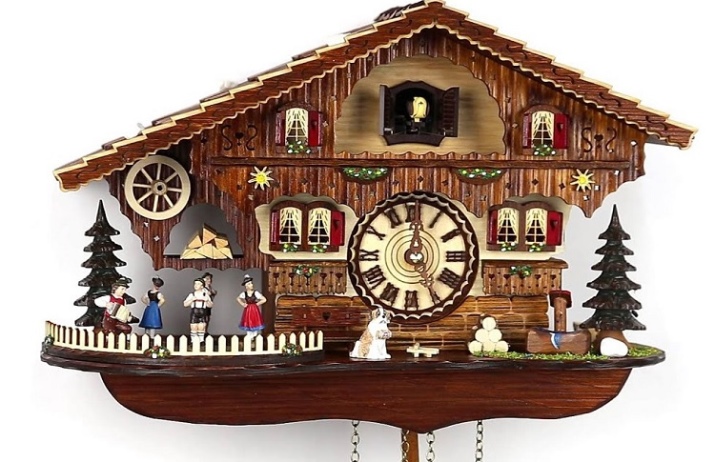





The size of the pendulum affects the amount of cuckoo or beat sounds produced. Two chains with two weights attached at the ends, made in the form of cast iron cones, are designed to wind the watch. The larger the counterweight, the less often the watch is wound. Heavy weights allow you to wind them up for a week, with small weights the watch needs a daily winding. And the duration of the plant, in turn, depends on the tonality and speed of forging.
With a weekly plant, this is slower. You can start the clock manually by simply swinging the pendulum.

In the same unchanged form, the wall cuckoo clock has survived to this day. However, over time, their mechanism has undergone changes and is constantly being improved. The modern watch movement is driven by the weight of weights or by a spring drive. The cuckoo figurine is capable of moving, bending, opening and closing its beak. Ultra-precise mechanisms have been developed that allow them to work for a longer and more trouble-free operation.
The market offers a very wide range of wall and table cuckoo clocks in a modern design. The variety of the model range depends on the mechanism used, the set of functions, case material and dimensions. All modifications have structural features of the mechanism and undeniable advantages.
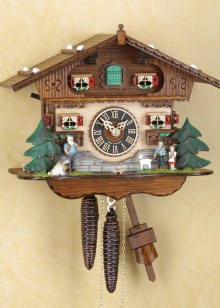


The most popular modern mechanical interior wall cuckoo clocks are produced by the famous German company Hubert Herr with more than 100 years of history. The products of this company are supplied to most countries of the world, including Russia, and the demand for it is constantly growing.
Modern models - quartz and electronic watches - run on batteries or are powered by an electrical network. They are distinguished by their versatility - this is their main advantage. In them, you can set various time modes for connecting functions, turn off the sound signal on certain days and hours, for example, on weekends or at night, adjust the volume. Their work in this case will not change, the accuracy will remain the same as before.
There is a clock with a built-in photocell, which, when it gets dark in the room, is switched to silent mode. Quartz and electronic devices are easy to handle. You just need to replace the batteries in time.



The leading manufacturers of quartz cuckoo clocks are the Japanese firms Casio and Orient, the Swiss company Tissot. Nice watches with modern design with quartz movements are produced in Korea, China, Russia and Germany. Low-budget models are offered by Korean manufacturers. The South Korean company Sinix has been very popular in Russia since the 90s. The company creates only a wide range of quartz models. These are classic wall clocks, striking clocks, and cuckoo clocks, as well as wall clocks with a pendulum, and, of course, floor and table options.
But still completely abandoning retro models, replacing them with modern ones with new technologies, will never work... The appeal to folk motives is more and more popular among interior designers and lovers of folklore traditions.


Valuable rarities
Traditionally, the most valuable are antique pieces by the masters of the past from Germany. Their undoubted advantage is the old mechanism, the work of which is flawless to this day. I would like to note that natural wood has preserved for the present generation the skill of ancient carvers who made carved cases with such ingenious weaves. This significantly increases the value of the rarities both aesthetically and in monetary terms.


But such priceless copies in perfect condition and with a working mechanism on the antiques market are now almost impossible to find. Despite the significant cost, the best examples of rare things have long been in private collections or in state museums. And in the antique market there are simply no required quantities of them. Among the Soviet rarities, the cuckoo clock produced by the Serdobsky Mayak plant has proven itself to be very reliable and accurate.
Made during the Soviet era, a variety of models can be found for every taste. They still serve today, counting the time and fit perfectly into the interior of any room.
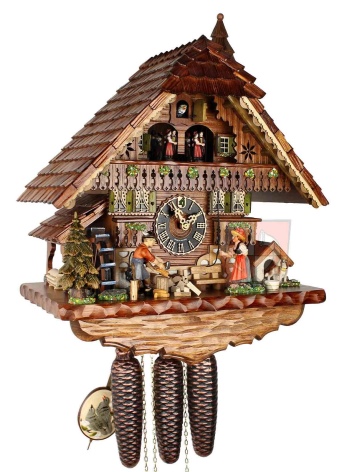

How to choose?
With a huge offer of modern watch devices, it is absolutely not a problem to find something for the soul. Designed for different possibilities, needs and aesthetic preferences - classic style, antique stylized or solid, representative class - all of them will complement any interior and emphasize the individual taste of their owner. And their comparative characteristics will help to determine the choice.
Mechanical cuckoo clock:
- high value from German and Swiss manufacturers with a high reputation, working in this area for over a century;
- have fewer functions;
- repair cheaper and faster;
- are distinguished by their longevity;
- lag behind by about 20 seconds per day;
- the metals and alloys used increase the weight.



Quartz Cuckoo Clock:
- the latest developments of modern technologies are applied;
- have high accuracy;
- the use of lightweight polymers reduces weight;
- ease of processing of polymeric materials allows you to diversify the design of the cases;
- their lineup is much wider;
- service life is much shorter;
- due to the complexity of the device, the mechanism is practically beyond repair.
The quality of watch products largely determines their service life. Therefore, the most in demand are products manufactured by the leaders of this market segment, which always have a consistently high quality.


The choice of the best model of timepieces currently depends on a person's belonging to a certain class, and on his aesthetic preferences. Some people prefer the classic options, while others are interested in novelties. The Nooka Cuckoo company, along with the traditional forms, produced wrist versions of cuckoo clocks, differing in a variety of color palette from the designer Hannes Griban. This is a flat cuckoo house with a dial on a soft strap made of a special rubber material. The mechanism is digital and the cuckoo, of course, does not pop up.The collection is exclusive and released in limited quantities.
By now, the clock has become less frequently used. In the modern world, they find out the time by a computer or mobile phone. And only a wall cuckoo clock is invariably in demand. And this does not surprise anyone, because they not only show us the current time, but also decorate the interior, creating that unique home atmosphere of comfort and coziness, which is less and less in the modern world.



In the next video you can take a closer look at the Trenkle 466 Q cuckoo clock.













The comment was sent successfully.